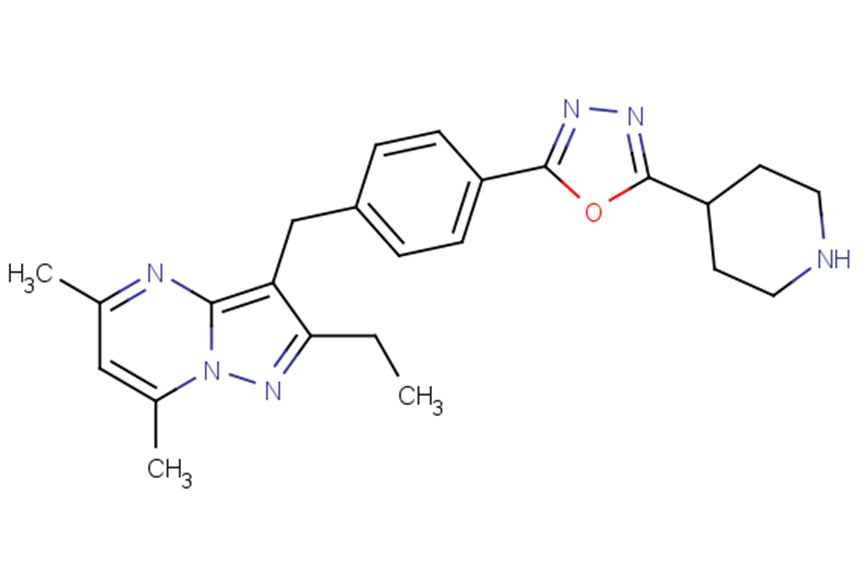
NE 52-QQ57
CAS No. 1401728-56-0
NE 52-QQ57( —— )
Catalog No. M21996 CAS No. 1401728-56-0
NE 52-QQ57 is a selective, and orally available antagonist of GPR4(IC50 : 70 nM),with anti-inflammatory activity.
Purity : >98% (HPLC)
 COA
COA
 Datasheet
Datasheet
 HNMR
HNMR
 HPLC
HPLC
 MSDS
MSDS
 Handing Instructions
Handing Instructions
| Size | Price / USD | Stock | Quantity |
| 5MG | 147 | In Stock |


|
| 10MG | 222 | In Stock |


|
| 25MG | 374 | In Stock |


|
| 50MG | 555 | In Stock |


|
| 100MG | 790 | In Stock |


|
| 200MG | Get Quote | In Stock |


|
| 500MG | Get Quote | In Stock |


|
| 1G | Get Quote | In Stock |


|
Biological Information
-
Product NameNE 52-QQ57
-
NoteResearch use only, not for human use.
-
Brief DescriptionNE 52-QQ57 is a selective, and orally available antagonist of GPR4(IC50 : 70 nM),with anti-inflammatory activity.
-
DescriptionNE 52-QQ57 is a selective, and orally available antagonist of GPR4(IC50 : 70 nM),with anti-inflammatory activity.
-
In VitroNE 52-QQ57 effectively blocks GPR4-mediated cAMP accumulation (IC50 26.8?nM in HEK293?cells).
-
In VivoNE 52-QQ57 (Compound 13) shows a significant anti-inflammatory effect in the rat antigen induced arthritis model after oral administration at 30 mg/kg bid for 20 days.NE 52-QQ57 (30 mg/kg bid po for 4 days) also prevents angiogenesis in the mouse chamber model as well as pain as demonstrated in the rat complete Freund’s adjuvant model. Animal Model:Female FVB mice (8-10 weeks)Dosage:30 mg/kg Administration:Oral, 4 days, bid Result:Treatment at 30 mg/kg p.o. bid starting on day 0, the day of the chamber implantation, showed a statistically significant reduction (46.8±10.6%) of tissue growth by day 4. The blood levels of 13 on day 4 at 2 and 16 h after compound application in this model were 9.03±2.87 and 0.09±0.06 μM.Animal Model:Male Wistar Han rats Dosage:3, 10, and 30 mg/kg Administration:Oral, 20 days, bid Result:Displayed not only higher exposures in the rat AIA but also lower plasma protein binding in rat (95%).
-
Synonyms——
-
PathwayOthers
-
TargetOther Targets
-
RecptorGPR4
-
Research Area——
-
Indication——
Chemical Information
-
CAS Number1401728-56-0
-
Formula Weight416.52
-
Molecular FormulaC24H28N6O
-
Purity>98% (HPLC)
-
SolubilityDMSO:5mg/ml (12 Mm; Need ultrasonic)
-
SMILESCCC1=NN2C(N=C(C)C=C2C)=C1CC1=CC=C(C=C1)C1=NN=C(O1)C1CCNCC1
-
Chemical Name——
Shipping & Storage Information
-
Storage(-20℃)
-
ShippingWith Ice Pack
-
Stability≥ 2 years
Reference
1. Hosford PS, et al. CNS distribution, signalling properties and central effects of G-protein coupled receptor 4. Neuropharmacology. 2018 Aug;138:381-392.
molnova catalog



related products
-
Gastrodin
Gastrodin, an anti-inflammatory polyphenol extracted from Chinese natural herbal Gastrodia elata Blume., benefits neurodegenerative diseases.
-
Malonic acid
Malonic acid (propanedioic acid) is the archetypal example of a competitive inhibitor: it acts against succinate dehydrogenase (complex II) in the respiratory electron transport chain. Malonic acid is found to be associated with malonyl-CoA decarboxylase deficiency which is an inborn error of metabolism.
-
Ruplizumab
Ruplizumab (BG 9588), a humanized monoclonal IgG1κ antibody targeting CD40L (TNF Receptor), holds promise for research in systemic lupus erythematosus disease .



 Cart
Cart
 sales@molnova.com
sales@molnova.com


